Regions
Durreck Range, Northern Zillertal Alps, Venediger Range, Southern Zillertal Alps and High Tauern
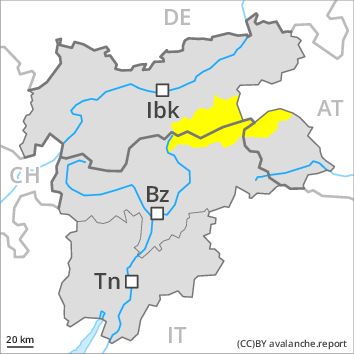
Danger level
Danger Level 2 - Moderate
Avalanche Problem
Wind-drifted snow above the treeline, N-NE-E-SE-S-SW-W-NW

Fresh snow and wind slabs require caution.
More recent wind slabs represent the main danger. The sometimes strong wind will transport the snow. As a consequence of fresh snow and a sometimes storm force wind, wind slabs will form as the day progresses in all aspects, in particular adjacent to ridgelines as well as in high Alpine regions. In high Alpine regions avalanche prone locations are more prevalent. The wind slabs can be released by a single winter sport participant in some cases above approximately 2200 m. In some cases avalanches are medium-sized.
Weakly bonded old snow: In very isolated cases avalanches can be released in the old snowpack and reach dangerously large size in particular on little-used, rather lightly snow-covered shady slopes. These avalanche prone locations are very rare and are difficult to recognise. Caution is to be exercised in particular at transitions from a shallow to a deep snowpack in little used backcountry terrain, in isolated cases also in areas close to the tree line.
Only isolated gliding avalanches and moist snow slides are possible.
Snowpack
dp 6: cold, loose snow and wind
10 to 15 cm of snow, and even more in some localities, will fall. The fresh snow will be deposited on a quite favourable old snowpack. As a consequence of the sometimes strong wind the wind slabs will increase in size additionally.
The snowpack will be subject to considerable local variations. The surface of the snowpack will freeze to form a strong crust. High altitudes and the high Alpine regions: The various wind slabs have bonded quite well with the old snowpack. Faceted weak layers exist deeper in the old snowpack, especially on steep shady slopes.
Tendency
Slight increase in avalanche danger as a consequence of fresh snow and wind.
Regions
Val Müstair Alps, Langtaufers, Eastern Verwall Mountains, Schnals Ridge, Southern Stubai Alps, Samnaun Mountains, Northern Oetz and Stubai Alps, Saldurn-Mastaun Ridge, Western Tuxer Alps, Texel Mountains, Eastern Tuxer Alps, Western Kitzbühel Alps, Western Pfunderer Mountains, Glockturm Range, Eastern Pfunderer Mountains, Weißkugel Range, Western Rieserferner Mountains, Gurgler Range, Western Deferegger Alps, Central Stubai Alps, Ortler Range, Eastern Lechtal Alps - Ammergau Alps, Mieming Mountains, Eastern Rieserferner Mountains, Karwendel Mountains, Glockner Range, Eastern Deferegger Alps, Brandenberg Alps, Schober Mountains, Central Lechtal Alps, Grieskogel Mountains
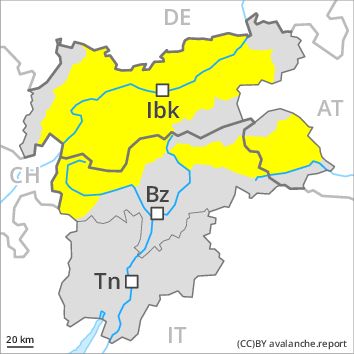
Danger level
Danger Level 2 - Moderate
Avalanche Problem
Wind-drifted snow above the treeline, N-NE-E-SE-S-SW-W-NW

Fresh wind slabs represent the main danger.
As a consequence of fresh snow and a moderate to strong wind, mostly small wind slabs will form over a wide area. The wind slabs can be released by a single winter sport participant in some cases in all aspects above the tree line. In the regions where more snow falls the avalanche danger is greater. In high Alpine regions avalanche prone locations are more prevalent. In some cases avalanches are medium-sized.
Weakly bonded old snow: In very isolated cases avalanches can be released in the old snowpack and reach dangerously large size in particular on little-used, rather lightly snow-covered shady slopes. These avalanche prone locations are very rare and are difficult to recognise.
Snowpack
dp 6: cold, loose snow and wind
In some regions up to 10 cm of snow, and even more in some localities, will fall. The fresh snow will be deposited on a quite favourable old snowpack. The surface of the snowpack has frozen to form a strong crust. The snowpack will be subject to considerable local variations. As a consequence of the sometimes strong wind the wind slabs will increase in size additionally. Faceted weak layers exist in the old snowpack.
Tendency
Moderate, level 2. In places where more snow falls the avalanche danger is greater.
Regions
Western Lechtal Alps, Western Verwall Mountains, Allgäu Alps, Silvretta
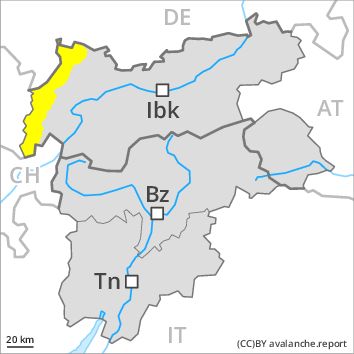
Danger level
Danger Level 2 - Moderate
Avalanche Problem
Wind-drifted snow above 2200m, N-NE-E-SE-S-SW-W-NW

Fresh snow and wind slabs require caution.
More recent wind slabs represent the main danger. The sometimes strong wind will transport the snow. As a consequence of fresh snow and a sometimes storm force wind, wind slabs will form as the day progresses in all aspects, in particular adjacent to ridgelines as well as in high Alpine regions. In high Alpine regions avalanche prone locations are more prevalent. The wind slabs can be released by a single winter sport participant in some cases above approximately 2200 m. In some cases avalanches are medium-sized.
Weakly bonded old snow: In very isolated cases avalanches can be released in the old snowpack and reach dangerously large size in particular on little-used, rather lightly snow-covered shady slopes. These avalanche prone locations are very rare and are difficult to recognise. Caution is to be exercised in particular at transitions from a shallow to a deep snowpack in little used backcountry terrain, in isolated cases also in areas close to the tree line.
Below approximately 2200 m: Only isolated gliding avalanches and moist snow slides are possible.
Snowpack
dp 6: cold, loose snow and wind
10 to 20 cm of snow, and up to 30 cm in some localities, will fall. The fresh snow will be deposited on a quite favourable old snowpack. As a consequence of the sometimes strong wind the wind slabs will increase in size additionally.
The snowpack will be subject to considerable local variations. High altitudes and the high Alpine regions: The various wind slabs have bonded quite well with the old snowpack. Faceted weak layers exist deeper in the old snowpack.
Especially below approximately 2200 m: The snowpack will be moist. The surface of the snowpack is frozen, but not to a significant depth.
Tendency
Further increase in avalanche danger as a consequence of fresh snow and wind.
Regions
Southern Adamello, Primiero - Pale di S. Martino, Adamello - Presanella, Northern Brenta - Peller, Southern Brenta, Fassa Valley, Southern Lagorai, Sole, Pejo and Rabbi, Northern Lagorai, Latemar, Maddalene, Pine' - Mocheni Valley

Danger level
Danger Level 2 - Moderate above 2000m
Danger Level 1 - Low above 2000m
Avalanche Problem
Wind-drifted snow above 2000m, N-NE-E-NW
Wet snow above 2000m, SE-S-SW-W

The backcountry touring conditions are mostly favourable. Little snow will fall in some localities.
The rather small wind slabs have bonded quite well with the old snowpack. These can only be released by large loads in most cases. The avalanche prone locations are to be found in particular on steep northwest to north to southeast facing slopes above approximately 2000 m, especially in gullies and bowls, and behind abrupt changes in the terrain. These places are clearly recognisable to the trained eye.
In steep terrain there is a danger of falling on the icy crust.
Snowpack
The fresh and somewhat older wind slabs are mostly small and can only be released in isolated cases. In some cases relatively hard layers of snow are lying on old snow containing large grains. Individual weak layers exist deep in the snowpack on shady slopes. The snowpack will be subject to considerable local variations. The surface of the snowpack will freeze to form a strong crust and will soften during the day. Below approximately 2000 m only a little snow is lying on south and southwest facing slopes.
Tendency
The avalanche danger will persist.
Regions
Gröden Dolomites, Prags Dolomites, Sarntal Alps, Lienzer Dolomites, Sexten Dolomites, Ulten Valley, Eastern Nonsberger Alps, Northern Dolomites of Fiemme
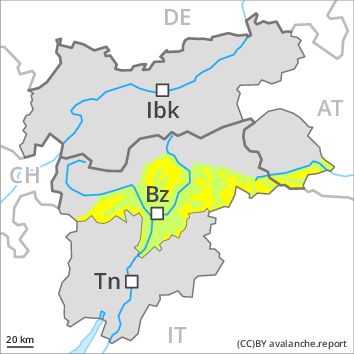
Danger level
Danger Level 2 - Moderate above the treeline
Danger Level 1 - Low above the treeline
Avalanche Problem
Wind-drifted snow above the treeline, N-NE-E-SE-NW

Fresh wind slabs require caution.
As a consequence of fresh snow and a sometimes strong wind, mostly small wind slabs will form over a wide area. The avalanche prone locations are to be found in particular on steep northwest to north to southeast facing slopes, especially in gullies and bowls, and behind abrupt changes in the terrain. The various wind slabs have bonded quite well with the old snowpack. These places are clearly recognisable to the trained eye.
Only isolated gliding avalanches and moist snow slides are possible.
Snowpack
dp 6: cold, loose snow and wind
In some regions up to 5 cm of snow. will fall. The fresh snow will be deposited on the quite favourable surface of an old snowpack. The surface of the snowpack will freeze to form a strong crust. The snowpack will be subject to considerable local variations. The fresh wind slabs are mostly small and can only be released in isolated cases. Individual weak layers exist deep in the snowpack on shady slopes. Below approximately 2000 m only a little snow is lying on south and southwest facing slopes.
Tendency
Moderate, level 2.
Regions
Wilder Kaiser Mountains - Waidring Alps, Eastern Kitzbühel Alps
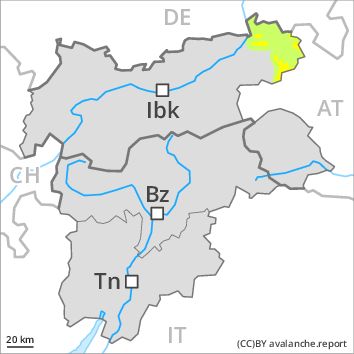
Danger level
Danger Level 2 - Moderate above the treeline
Danger Level 1 - Low above the treeline
Avalanche Problem
Wind-drifted snow above the treeline, N-NE-E-SE-S-SW-W-NW

The backcountry touring conditions are mostly favourable.
As a consequence of fresh snow and a sometimes strong wind, mostly small wind slabs will form over a wide area. The avalanche prone locations are to be found in particular on steep northwest to north to southeast facing slopes, especially in gullies and bowls, and behind abrupt changes in the terrain. The various wind slabs have bonded quite well with the old snowpack. These places are clearly recognisable to the trained eye.
Only isolated gliding avalanches and moist snow slides are possible.
Snowpack
dp 6: cold, loose snow and wind
In some regions up to 5 cm of snow, and even more in some localities, will fall. The snowpack will be subject to considerable local variations. The fresh snow will be deposited on the quite favourable surface of an old snowpack. In some cases relatively hard layers of snow are lying on old snow containing large grains. Individual weak layers exist deep in the snowpack on shady slopes. Below approximately 2000 m only a little snow is lying on south and southwest facing slopes.
Tendency
Slight increase in avalanche danger as a consequence of fresh snow and wind.
Regions
Prealps, Cembra Valley, Bondone and Stivo, Vallarsa, Western Nonsberg Alps, Folgaria - Laverone, Ledro Valley, Paganella, Marzola - Valsugana
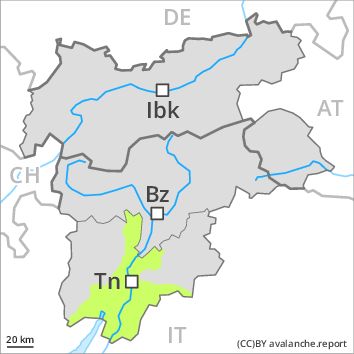
Danger level
Danger Level 1 - Low
Avalanche Problem
Wet snow, SE-S-SW-W-NW

The snowpack will be generally well bonded. The conditions are mostly favourable. Little snow will fall in some localities.
The rather small wind slabs have bonded quite well with the old snowpack. These can only be released by large loads in most cases. The avalanche prone locations are to be found in particular on steep northwest to north to southeast facing slopes, especially in gullies and bowls, and behind abrupt changes in the terrain. In steep terrain there is a danger of falling here. The early morning will see quite favourable conditions generally, but the avalanche danger will increase later.
Snowpack
Wind slabs are mostly small and can only be released in isolated cases. In some cases relatively hard layers of snow are lying on old snow containing large grains. Faceted weak layers exist deep in the snowpack on shady slopes. The snowpack will be subject to considerable local variations. The surface of the snowpack will freeze to form a strong crust and will soften during the day. On south and southwest facing slopes a little snow is lying in all altitude zones.
Tendency
The avalanche danger will persist.







